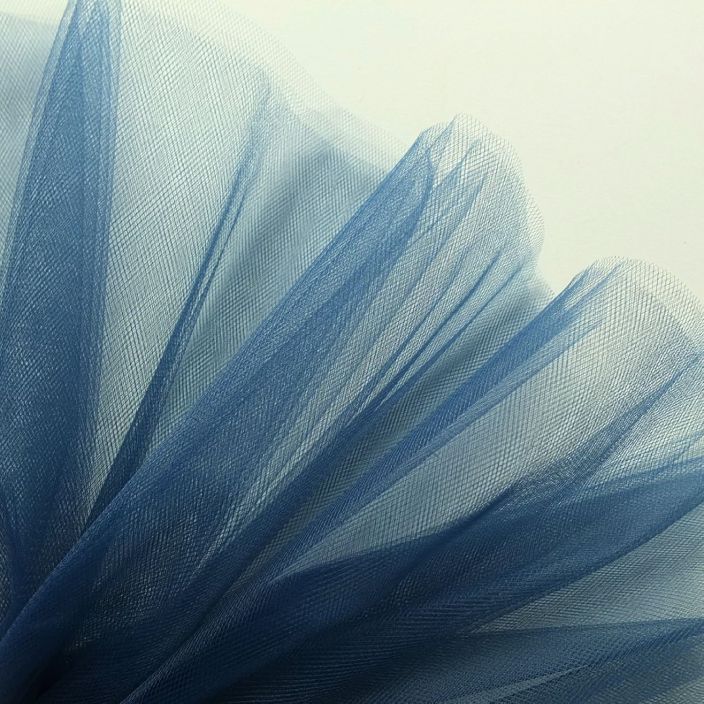For best prices and early deliveries, WhatsApp us at. 918488070070

Tulle
Tulle is a delicate, sheer textile celebrated for its lightweight, net-like structure. Originating in the 18th century in Tulle, France, this versatile material is typically crafted from nylon, polyester, or silk, offering a fine, open weave that combines airiness with subtle structure. Tulle material is prized for its soft, flowing drape, which creates voluminous silhouettes, ideal for warm climates due to its breathability. The soft tulle fabric’s adaptability allows it to be dyed in a spectrum of colours, from classic whites to vibrant hues, and embellished with embroidery, sequins, or glitter, catering to both minimalist and ornate designs. Its delicate yet durable nature makes it a staple across diverse applications, from high-end couture to costume styling. In fashion, tulle fabric is synonymous with bridal and evening wear, used in wedding veils, ball gowns, and layered skirts, where soft tulle material adds a dreamy, elegant touch. Beyond women’s attire, tulle material appears in avant-garde menswear and children’s costumes, enhancing festive or theatrical looks. In home décor, soft tulle fabric is employed in sheer curtains, canopies, and event drapery, imparting a light, sophisticated ambience. Environmentally, silk tulle fabric is sustainable but resource-intensive, whereas synthetic tulle material is less eco-friendly due to its non-biodegradable nature.
The Making of Tulle
The production of tulle fabric is a precise process that creates a lightweight, sheer woven fabric with a distinctive net-like structure, widely used in fashion and home décor. Crafted from silk, nylon, or polyester, tulle material is valued for its delicate, airy texture, achieved through specialised knitting or weaving techniques.
The process begins with fibre selection. For soft tulle material, silk is sourced from silkworm cocoons, with filaments carefully extracted to ensure a smooth, luxurious finish. Synthetic tulle fabric, typically nylon or polyester, is created by extruding molten polymer through fine spinnerets, forming strong, uniform filaments. These fibres are spun into fine, lightweight yarns designed to maintain the open, mesh-like quality of tulle material. Silk yarns require gentle handling to preserve their natural sheen, while synthetic yarns offer durability and ease of production.
The core of tulle production lies in creating its net-like structure, typically through warp knitting or, less commonly, weaving. Warp knitting machines, such as those using a tricot or Raschel technique, interlock yarns to form a hexagonal or diamond-shaped mesh, giving tulle fabric its characteristic transparency and slight stretch. For silk tulle fabric, silk yarns are knitted with precision to achieve a delicate drape, while synthetic tulle material allows for faster, more robust knitting, producing stiffer or softer variants depending on the intended use, such as tutus or veils.
Post-knitting, tulle textile undergoes finishing. Scouring removes impurities, particularly for silk tulle fabric, which demands careful treatment to avoid fibre damage. Stiffening treatments, often applied to synthetic tulle fabric, enhance structure for voluminous designs, while silk soft tulle material may be calendered for a subtle sheen. Embellishments like glitter or embroidery are added for decorative purposes.
Utility
In women’s fashion, tulle material is a hallmark of bridal and evening wear, prominently featured in wedding veils, ball gowns, and lehengas. Soft tulle fabric, often silk-based, drapes elegantly for romantic, flowing silhouettes, ideal for bridal dresses or sarees with delicate overlays. Synthetic tulle fabric, typically nylon or polyester, provides durability and affordability, and it is used in tutus, skirts, or layered dresses for a whimsical, voluminous effect. Embellished tulle material with glitter or lace enhances formal attire, while plain versions suit casual tops or accessories like scarves, blending elegance with modern trends.
For men, tulle fabric is less common. Still, it appears in avant-garde fashion, such as sheer overlays in jackets or kurtas, adding a contemporary, lightweight touch to traditional or experimental designs. Its breathability ensures comfort, particularly in warmer climates, with subtle patterns or textures elevating the aesthetic for special occasions.
Kidswear designers use soft tulle material for its gentle texture, perfect for festive dresses or fairy-tale-inspired costumes. Layered tulle fabric creates playful, voluminous skirts or lehengas for birthdays or celebrations, with pastel or glittery variants adding a magical charm while maintaining comfort for young wearers.
In home décor, tulle material enhances interiors with a soft, delicate appeal. Sheer tulle fabric curtains filter light, creating a dreamy ambience in bedrooms or living areas. It is also used in decorative drapery, table runners, or chair sashes for events, adding a touch of sophistication. Soft tulle fabric can be layered for canopies or wall hangings, introducing an airy, elegant aesthetic to spaces.
Image Credits
Ubay